Seamanship
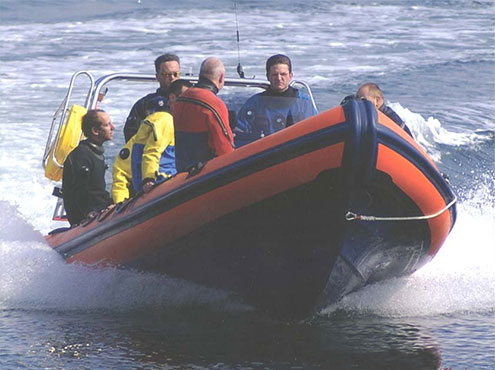
Dive Boats
- You should drive your boat cautiously in the vicinity of divers in the water. Those in the boat should keep an eye out for divers surfacing unexpectedly.
- When dropping divers or recovering them into the boat, the engine should be in neutral. After dropping divers, make sure they are well clear of the propeller before engaging gear.
- We recommend that the helmsman should use an engine kill-cord In accordance with the manufacturer's recommendations.
- Dive boats should display the internationally recognised flag 'Alpha' when diving is underway to warn other boats to keep clear. It should not be displayed unless diving operations are actually in progress.
- You should have third-party insurance cover.
- More information on boats, including what equipment you need to carry, is available in the document Guidelines for the safe operation of member club dive boats from the Combined Diving Association (CDA) (Adobe PDF | 242.4 KB) — UK publication, October 2017.
See also, Victorian Recreational Boating Safety Handbook (Adobe PDF | 14.08 MB) — A downloadable version of Marine Safety Victoria's Victorian Recreational Boating Safety Handbook, July 2020.
Diver Below Warning
A 5 Knot speed limit applies to vessel operators and water skiers within 100 metres of a vessel, buoy or structure on which a 'diver below' signal is displayed.
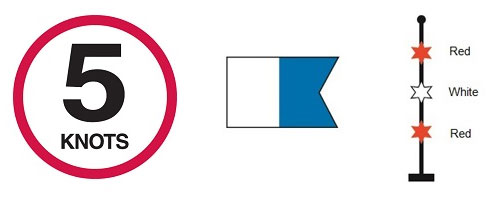
Any vessel with divers or snorkelers operating from it must always display signals by day or night to inform other vessel users. During night diving, a vessel must show the international signal for a vessel restricted in its ability to manoeuvre. Always be aware that divers in the water may not be near a vessel.
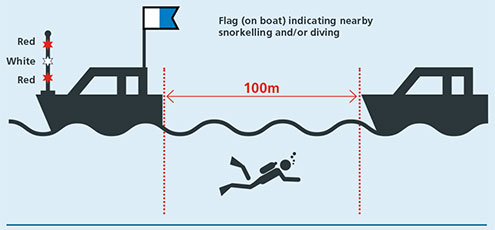
Distress at Sea
- VHF/DSC radio is the primary means of calling the emergency services from a boat when diving at sea around Australia.
- If someones life or the vessel is in danger you should make a Mayday call.
- You can either make a voice call on Channel 16 or send a distress alert via Digital Selective Calling (DSC).
- You should put out a Pan Pan call for serious problems that are not life-threatening.
- In emergencies, you are allowed to use the radio even if you don�t have a formal licence. If you are unsure what to do, and there are no trained radio operators on board, pressing and holding the red DSC button will send a distress message to the emergency services and other vessels in the vicinity automatically.
- Do not delay calling for help for too long, if you are convinced problems are arising that you cannot control. Emergency services reports, each year, indicate that some divers leave it too long before raising the alarm.
- Alternative methods of alerting the emergency services at sea include:
- Attracting attention by firing flares (do not waste flares, only fire them if you think someone will see them)
- Mobile phones (but mobiles only works very close to land and if there is signal coverage) it is a good idea to find out the number(s) of the local emergency services before you set out to sea
- Boats should have an Emergency call checklist displayed in a location convenient for the radio.
See also Marine Radio Operation.
Designated Hazardous Area
— Port Phillip Heads
Port Phillip Heads means all the waters between an imaginary line drawn between Shortland Bluff and Point Nepean, and the seaward limits of an imaginary line consisting the arc of a circle with a radius of three nautical miles centred on Point Lonsdale (as indicated in red above). This definition of Port Phillip Heads now includes the area at the entrance to Port Phillip where conditions are known to present additional risks to vessels operating there. Port Phillip Heads and any area of State waters declared by the Safety Director is classified as a Designated Hazardous Area. For more see transportsafety.vic.gov.au/msv/heads
The defined area is shown in the diagram below:
LIFEJACKET WEAR IS MANDATORY IN THE RED AREA
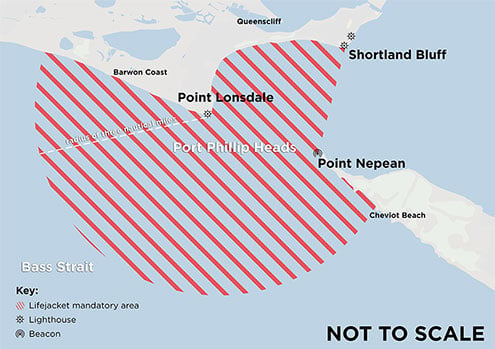
Pots, Markers, and Fishing Gear
- You should try to avoid diving near lobster or crab pots, or other fishing gear. Not only is there a risk of getting your propeller or divers at the surface caught up in loose line, there are also underwater risks of entanglement for the divers.
Propeller Guards
- A propeller guard, fitted to an outboard motor, gives a degree of protection from injuries to divers.
- Before fitting a propeller guard, take note of the manufacturer�s recommendations and instructions, as it is possible to cause stress to the gear box and low end of the engine. Some loss of power may result from fitting a propeller guard.
See also Marine Safety Victoria: Propeller Strike.
Marine Charts
Appropriate Australian navigation charts of the area being navigated must be carried onboard. This is to provide adequate information concerning the departure point and dive sites being visited plus alternative havens in the event of changes in local weather and sea conditions.
For Port Phillip the charts are: Aus 143, Aus 144, Aus 153, Aus 154, Aus 155, Aus 157 and Aus 158. These can be purchased through mapping retailers and the Australian Hydrographic Service.
VHF/DSC Radios
- VHF/DSC radios are an important means of communication at sea (see Distress at sea).
- If you are using a radio in a non-emergency situation, then the boat should have a marine VHF installation license, and you will need to have a marine radio certificate of competency yourself (or be supervised by someone who has).
- VHF marine radios sold since 2000 are fitted with digital selective calling (DSC). DSC sets allow you to call a specific vessel, but they often have a red emergency button that allows someone to automatically call the emergency services and other DSC equipped vessels in an emergency.
Weather for Divers
- You should check the weather regularly. There are many good websites providing marine forecasts for several days ahead, see Weather, Tides, Conditions etc. for links to the latest information about Melbourne and Victoria diving conditions.
- VHF Radio weather services — Marine Radio Victoria (MRV) provides twice daily local weather forecasts on VHF radio, with instructions and broadcast times announced regularly on Channel 16. MRV also broadcast current weather warnings at 00:47, 02:48, 04:48, 06:48, 08:48, 10:48, 12:48, 14:48, 16:48, 18:48, 20:48 and 22:48 eastern standard time (EST) on VHF channel 67 following the initial broadcast until notice of the cancellation is received by the Bureau of Meteorology.
- The Bureau of Meteorology issues a:
- Strong wind warning
For winds averaging more than 25 knots and up to 33 knots - Gale warning
For winds averaging 34 knots and up to 47 knots - Storm warning
For winds averaging 48 knots or more
- Strong wind warning
- Small craft should not to go boating when one of the above weather warnings has been issued.
- In general, you should not dive if it is windier than a Force 4 on the Beaufort scale in open seas. (Force 4: Moderate breeze, 7�10 knots (8�12 mph, 12�19 km/h) wind speed, 0.6�1.2 metre (2�4 ft) wave height, and sea conditions of Large wavelets; crests begin to break; foam of glassy appearance; perhaps scattered white horses)
- It may be possible to dive safely in much stronger winds if the dive site is sheltered from the prevailing wind, and the boat journey to and from the dive site is navigable in the prevailing conditions.
- There may be occasions when the sea state is too rough to dive, even if the wind is 'only' a Force 4. There will be many factors that influence this, including what the weather has been doing for the previous few days, what the currents are like in that area, and what the underwater topology is like.
- As well as the sea state, other aspects of weather can affect diving safety.
- Fog can be a problem, increasing the risk of lost divers and collisions with other vessels.
- Hot, sunny days bring the risk of sunburn and dehydration.
- Very cold days bring the risk of exposure, and even hypothermia, for divers in open boats.
- If you are diving at an unfamiliar dive site, it's a good idea to talk to someone who is familiar with the local area and weather who may be able to give you tips.
Oxygen Administration Kit for Divers
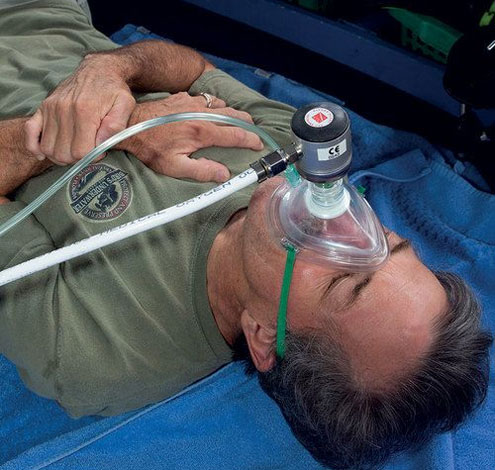
Oxygen Delivery With A Demand Valve
An oxygen kit must be regarded as essential first aid equipment in the event of any diving injury but especially Decompression Illness (DCI). The kit should be of an approved type and be maintained in a fully functional order. The cylinder(s) pressure should be checked prior to each trip to sea and only full cylinders should be carried. Part empty cylinders must be replaced or filled before departure.
Following a diving related injury, the administration of oxygen is considered an important first aid measure. Oxygen should be administered as early as possible and should be administered continuously until the casualty is handed over to specialist medical care.
The goal is to deliver oxygen at the highest possible oxygen concentration while being mindful of oxygen supply limits. Oxygen systems commonly used for dive accidents can have two delivery options: a pressure-activated demand valve, or constant flow for use with a non-rebreather mask. The demand valve is an easy-to-use system that conserves the oxygen supply since it releases oxygen only when the user inhales.
A suitable oxygen kit may be:
- Standard medical oxygen cylinder, size D (10 litre WC, 1,700 litre O2) or E (23 litre WC, 4,000 litre O2).
- Oxygen regulator incorporating a cylinder contents gauge and providing an outlet for at least one demand unit, and an outlet capable of delivering oxygen at a constant flow of 10 litres/minute
- Demand unit, hose and oro-nasal mask. The standard demand valve allows oxygen to flow freely for the treatment of conscious divers. The dual-function manually triggered ventilator can be used to ventilate divers who are not breathing.
- Pocket mask incorporating an oxygen connection elbow and a suitable hose for the delivery of oxygen at a constant flow of 10 litres/minute
Some demand units incorporate a positive pressure ventilation facility. If incorporated, this should be limited to a flow rate of 40 litres/minute and should also incorporate an overpressure relief valve, which limits the airway overpressure to a maximum of 45cm H2O. In demand mode, the unit should be able to deliver a maximum demanded flow rate in excess of 100 litres/minute.
Oxygen to be carried — The amount of Oxygen actually carried on the boat must reflect the normal operating range and must ensure that there is sufficient to ensure that the oxygen is not exhausted before handing a casualty into the care of the emergency services. Carrying an Oxygen Pin Index to F DIN Adaptor enables dive cylinders with oxygen to be used for additional capacity.
Fluids — The administration of still fluids is believed to be beneficial in the First Aid treatment of DCI. A minimum of 2 litres still fluid should be carried to allow for administration at a rate of 1 litre per hour. When diving more remote areas, additional fluids should be carried.
Buoyancy Aids
Dry Suits — Many dry suits, both membrane and neoprene, are often considered to provide adequate buoyancy for the wearer if they fell into the water. This buoyancy is only provided if the suit's zip has been completely closed, so it is essential that all dry suit zips are closed completely and checked by a buddy prior to moving away from the safety of the mooring location. Suits should not be relied upon to provide suitable flotation in the event of falling overboard and it is highly recommended that a lifejacket is worn in addition to a closed dry suit, especially for long sea trips.
Weight Belts — Divers should not wear weight belts in the boat unless preparing to dive or wearing an appropriate buoyancy aid that will compensate for the additional weight.
Helmsman — The boat's helmsman should always wear a lifejacket while operating in that role.
More Information
See the Melbourne Dive Sites section of this website for maps and detailed descriptions of local and Victorian dive sites.
See the Diving and Snorkelling Downloads section of this website to download GPS marks for Melbourne and Victorian dive sites, plus get more detailed information about boating on Port Phillip and Western Port.
Dive Boat Related Downloads
The Dive Boat Related files on our Diving and Snorkelling Downloads web page are valuable references that will help you to better setup your boat for diving, and help you to conduct safe diving operations.
- VSAG Recommended Club Dive Boat Equipment (Adobe PDF | 170.77 KB) — November 2012
- Guidelines for the safe operation of member club dive boats from the Combined Diving Association (CDA) (Adobe PDF | 242.4 KB) — UK publication, October 2017
- BSAC Small Boat Safety Checklist (Adobe PDF | 2.07 MB)
- BSAC Voyage Planning Sheet (Adobe PDF | 55.38 KB)
- Marine Safety Victoria - I've Gone Boating flyer (Adobe PDF | 212.22 KB)
- Marine Safety Victoria - Vessel Pre-Trip Checklist (Adobe PDF | 156.8 KB)
- Marine Safety Victoria - Skipper's Manual (Adobe PDF | 2.13 MB) — Keep a copy on your dive boat.
- Marine Safety Victoria - Vessel Refuelling Safety Checklist (Adobe PDF | 152.79 KB) — Keep a copy on your dive boat.
- Victorian Recreational Boating Safety Handbook (Adobe PDF | 14.08 MB) — A downloadable version of Marine Safety Victoria's Victorian Recreational Boating Safety Handbook, July 2020.
- Safety Equipment, July 2012 (Adobe PDF | 1.77 MB) — Factsheet on Maritime Safety from Transport Safety Victoria.
- Victorian Marine Safety Act 2010 (Adobe PDF | 979.83 KB)
- Victorian Marine Safety Regulations 2012 (Adobe PDF | 1.06 MB)
- Harbour Master's Directions for port waters of the Port of Melbourne (Adobe PDF | 2.74 MB) — 11th edition, May 2019
- Port Information Guide for the Port of Melbourne (Adobe PDF | 7.68 MB) — 4th edition, effective from 23 March 2018
- Port Phillip Recreational Boating Guide (Adobe PDF | 10.32 MB) — 7th edition, June 2019
- Western Port Recreational Boating Guide (Adobe PDF | 5.65 MB) — 5th edition, June 2011
- Port of Hastings Harbour Master�s Directions (Adobe PDF | 1.73 MB) — August 2019
- Raydon Boat Safety and Dive Equipment (Adobe PDF | 281.3 KB) — An example information sheet. Create your own version, print and laminate it, and keep it on your dive boat.
- Raydon Dive and Boat Captain Information Sheet (Adobe PDF | 197.78 KB) — An example emergency information sheet. Create your own version, print and laminate it, and keep it on your dive boat.
- Raydon Boat Participation Agreement and Consumer Waiver (Adobe PDF | 15.68 KB) — Every time you have divers coming out to participate in scuba diving activities from your dive boat ask them to read, understand and consent to the terms of a Boat Participation Agreement and Consumer Waiver. Create your own version, print and laminate it. Keep it clearly displayed on your dive boat.
- Raydon Boat Diving Consent Form (Adobe PDF | 155.5 KB) — Create your own version, print copies and have every diver coming out to participate in scuba diving activities from your dive boat read, understand and sign it.
- Dive Management Sheet (Adobe PDF | 388.58 KB) — Use this form to record what happens on each dive from your dive boat.
- Radio Safety Information (Adobe PDF | 403.94 KB) — How to make an emergency radio call. Print and laminate this and keep it on your dive boat.

